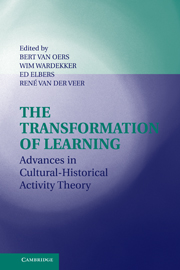Book contents
- Frontmatter
- Contents
- List of Contributors
- Preface
- INTRODUCTION
- SECTION ONE TENETS OF ACTIVITY THEORY
- SECTION TWO IDENTITY, DIVERSITY, AND INCLUSION
- Introduction to Section Two: Identity, Diversity, and Inclusion
- 9 Identity Shifts in Informal Learning Trajectories
- 10 No Human Being Is Illegal: Counteridentities in a Community of Undocumented Mexican Immigrants and Children
- 11 Cultural Identity and Emigration: A Study of the Construction of Discourse about Identity from Historical-Cultural Psychology
- 12 Diversity in the Construction of Modes of Collaboration in Multiethnic Classrooms: Continuity and Discontinuity of Cultural Scripts
- 13 “Discourse” in Cultural-Historical Perspective: Critical Discourse Analysis, CHAT, and the Study of Social Change
- 14 Reason and Dialogue in Education
- SECTION THREE DYNAMICS OF ACTIVITY AND THE VARIATIONS OF LEARNING
- Index
- References
9 - Identity Shifts in Informal Learning Trajectories
Published online by Cambridge University Press: 25 August 2009
- Frontmatter
- Contents
- List of Contributors
- Preface
- INTRODUCTION
- SECTION ONE TENETS OF ACTIVITY THEORY
- SECTION TWO IDENTITY, DIVERSITY, AND INCLUSION
- Introduction to Section Two: Identity, Diversity, and Inclusion
- 9 Identity Shifts in Informal Learning Trajectories
- 10 No Human Being Is Illegal: Counteridentities in a Community of Undocumented Mexican Immigrants and Children
- 11 Cultural Identity and Emigration: A Study of the Construction of Discourse about Identity from Historical-Cultural Psychology
- 12 Diversity in the Construction of Modes of Collaboration in Multiethnic Classrooms: Continuity and Discontinuity of Cultural Scripts
- 13 “Discourse” in Cultural-Historical Perspective: Critical Discourse Analysis, CHAT, and the Study of Social Change
- 14 Reason and Dialogue in Education
- SECTION THREE DYNAMICS OF ACTIVITY AND THE VARIATIONS OF LEARNING
- Index
- References
Summary
The English government is currently exercised by a breakdown in social cohesion, which is evidenced in the number of citizens who find themselves at risk of social exclusion, that is, disconnected from those networks which bind people into socially beneficial systems. One strand of the policy response is aimed at enhancing local social capital in order to support the participation of individuals in opportunities to be made available to them. This policy line is a sophisticated and complex response. It aims to intervene in the lives of individuals, their families, and their communities in order to disrupt patterns of social exclusion and to offer new pathways of participation, while helping to develop the wherewithal of individuals to engage with these opportunities. The argument therefore runs that if one is to change lives, one needs to change the environments that shape and are shaped by those lives.
This approach therefore appears to have much in common with sociocultural and activity theory (SAT) interpretations of the extent to which the social and cultural are incorporated in the individual. However, SAT analyses are usually strong in their drive from the social or cultural to the individual (Chaiklin, 2001; Engeström, 1987, 1999), but are arguably less well-developed when focussing on how individuals interpret and act in their social worlds. The individual, for example, appears curiously absent in the following accounts.
What we learn and what we know, and what our culture knows for us in the form of the structure of artefacts and social organisation are those chunks of mediating structure.[…]
Information
- Type
- Chapter
- Information
- The Transformation of LearningAdvances in Cultural-Historical Activity Theory, pp. 163 - 181Publisher: Cambridge University PressPrint publication year: 2008
References
Accessibility standard: Unknown
Why this information is here
This section outlines the accessibility features of this content - including support for screen readers, full keyboard navigation and high-contrast display options. This may not be relevant for you.Accessibility Information
- 23
- Cited by
